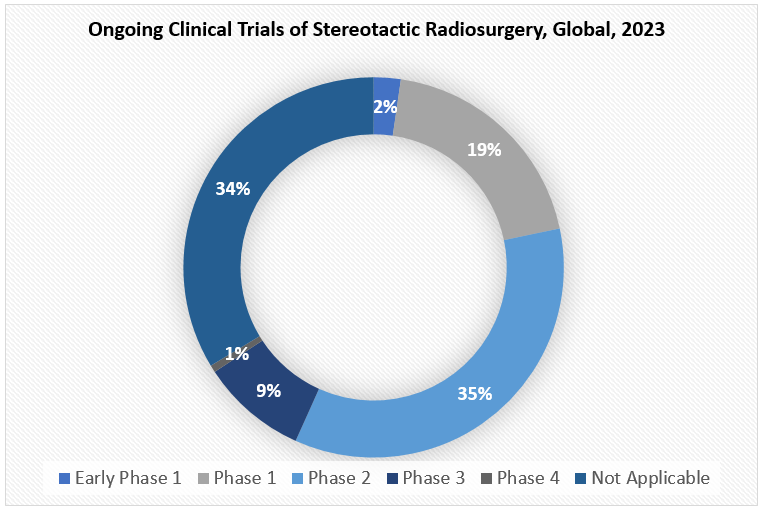Stereotactic Radiosurgery Market Seen Soaring 5.1% Growth to Reach USD 7.5 Billion by 2030, Projects Univdatos Market Insights
- Vikas Kumar
- November 15, 2023
- HEALTHCARE, NEWS
- Stereotactic Radiosurgery, Stereotactic Radiosurgery Market, Stereotactic Radiosurgery Market analysis, Stereotactic Radiosurgery Market forecast, Stereotactic Radiosurgery Market growth, Stereotactic Radiosurgery Market share, Stereotactic Radiosurgery Markettrends
- 0 Comments
Key Highlights of the Report:
- Growing prevalence of cancer cases: The rising incidence of cancer cases such as brain cancer, and prostate cancer due to the adaptation of bad lifestyle is driving the demand for stereotactic radiosurgery.
- Advancements through clinical trials: Continuous advancements in clinical trials and improvements in drug design are contributing to the growth of the stereotactic radiosurgery market. These advancements enable healthcare professionals to provide better treatment options to patients.
- Rising demand for advanced therapeutics: With the increasing emphasis on preventive healthcare, there is a growing demand for advanced therapeutics. Stereotactic radiosurgery using artificial intelligence might lead to improved patient outcomes.
According to a new report by Univdatos Market Insights, the Stereotactic Radiosurgery Market is expected to reach USD 7.5 Billion in 2030 by growing at a CAGR of 5.1%. Surgical stereotactic radiosurgery is a minimally invasive procedure that uses high-precision radiation to treat a wide range of medical issues, like brain tumors, AVM (arterial vein malformation) malignancies, and nerve damage in the trigeminal nerve. Stereotactic refers to a frame that’s used to guide the beams of radiation to the right spot. The stereotactic radiosurgery market is growing rapidly due to the increasing prevalence of chronic diseases like cancer. For example, in 2020, GLOBOCAN conducted a study on the incidence and prevalence of cancer in the world and estimated 308,102 new cancer cases diagnosed in the United States in 2020. Advances in technology have improved the accuracy and effectiveness of chronic disease treatment with minimally invasive procedures. This market is being boosted due to multiple factors like the rise in the geriatric population, increased expenditure in healthcare, and advancements in healthcare technologies. For instance, the World Health Organization (WHO) reported in October 2022 that between 2015 to 2050, the segment of the world’s population over 60 years will nearly double from 12% to 22%, which will propel the stereotactic radiosurgery market at a steady rate.
Access Sample PDF Here- https://univdatos.com/get-a-free-sample-form-php/?product_id=49172
The report suggests that Rising Research and Development is one of the major factors driving the growth of the stereotactic radiosurgery market during the forthcoming years. Clinical trials are essential for the development of new and modified models for treating deadly disorders, as they provide valuable information on the effectiveness of the devices involved. In recent years, there has been an increasing number of clinical trials followed by FDA approvals focused on stereotactic radiosurgery. For instance, the University of Pittsburgh conducted a clinical trial to determine the efficacy of giving pre-operative radiosurgery to patients pending resection of a brain metastasis in 2021. they are investigating new techniques that may be more effective than existing treatment procedures. The increasing number of clinical trials for stereotactic radiosurgery is driving the growth of the market, as it indicates a greater interest in developing new treatments for stereotactic radiosurgery. It also provides hope for patients suffering from chronic diseases like cancer which cannot be completely cured but symptoms can be significantly minimized.
Regarding new launches related to stereotactic radiosurgery, there have been several recent developments. There are several clinical trials being conducted to test the effectiveness of treatments provided through stereotactic radiosurgery for cancer, and Parkinsonian-like diseases. These trials are still ongoing, but the early results look promising. For instance, the University of Chicago started a clinical trial to determine if not treating planning target volume (PTV) margins during radiation therapy worsens progression-free survival rates in patients with brain metastases in 2016. The study is expected to be completed by 2026. Additionally, there have been some new product launches in the market for cancer treatment using artificial intelligence. AI has been increasingly incorporated into medical procedures in order to accomplish tasks that may be difficult for human clinicians to do on their own. One area of medical need is the early detection of rare diseases, as this is often delayed. For instance, in June 2023, India-based Apollo Cancer Centre launched CyberKnife S7 FIM Robotic RadioSurgery System which claims to deliver hypo-fractionated SRS/SBRT treatments using Synchrony AI-driven, real-time target tracking. It addresses diseases, including benign brain tumors, brain metastases, and select medically refractory functional indications.
Conclusion
Stereotactic radiosurgery owns the ability to deliver high doses of radiation directly to the affected area while minimizing damage to surrounding healthy tissue. This can provide relief from symptoms and improve quality of life for patients who may have been unable to undergo traditional surgery or who have experienced complications from previous treatments for getting relief from chronic diseases like cancer. The global stereotactic radiosurgery market is a rapidly growing field, with advancements in treatment methods leading to improved outcomes for patients. It is expected to continue to grow in the coming years. Overall, the global stereotactic radiosurgery market represents a significant opportunity for pharmaceutical companies and professionals in the field of clinical research. With continued research and development, it is likely that even more effective treatments will become available in the future, leading to improved outcomes for patients with chronic disorders.
Key Offerings of the Report
Market Size, Trends, & Forecast by Revenue | 2023−2030
Market Dynamics – Leading Trends, Growth Drivers, Restraints, and Investment Opportunities
Market Segmentation – A detailed analysis by Technology, Applications, End-user, and Region
Competitive Landscape – Top Key Vendors and Other Prominent Vendors



